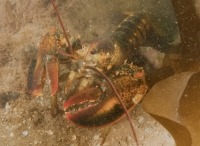
(Photo: Claire Goodwin)
American Lobster
Homarus americanus
American lobsters are typically around 20 to 61 centimetres long and around 0.5 to 4 kilograms in weight. The body is usually olive-green or greenish-brown. It has two large claws and a strong tail.
Authority
H. Milne Edwards, 1837
Classification Details
Phylum: Arthropoda (arthropods); Subphylum: Crustacea (crustaceans).
Habitat
Lobsters are nocturnal and in the daytime are usually found hiding in crevices in bedrock and between boulders. Typically found at depths of 4 to 50 metres, but have been recorded as deep as 480 metres. Found on the Atlantic coast of North America, from Labrador to New Jersey, with sporadic records as far south as North Carolina.
Diet
Predators/scavengers. Mainly eat molluscs (especially mussels), sea stars, urchins, and worms. May also eat other prey items including other crabs, fish, brittlestars, and anemones. They use their heavier claw for crushing prey and the narrower claw for tearing or cutting food. Like us, lobsters can be left or right-handed; the heavier claw can be on either side.
Reproduction
Lobsters are male or female. Mating takes place shortly after the female has moulted and her shell is soft. She attracts males by pheromones and, after courtship, the male inserts sperm packets using specialized swimming legs (pleopods). Once the eggs are fertilized, the female stores them under her tail for around 11 months. After hatching, the larvae spend about two months in the plankton before settling on the seabed. Because of their hard shell, lobsters have to grow by moulting. They moult up to 10 times in their first year. After the fourth year, they moult only once or twice per year. Scientists think that lobsters can live for as long as 100 years.
Fun Facts
American lobsters can reach a body length of 64 centimetres and a weight of over 20 kilograms. This makes them not only the heaviest crustacean but the heaviest living arthropod species.
Yellow, blue, and red pigments found in their shell give lobsters their colour. Sometimes, due to a genetic mutation, lobsters can’t make one or more of these pigments. The results of this are white, bright blue, and bright red lobsters.
References
Factor JF (1995) Biology of the lobster Homarus americanus. San Diego: Elsevier.
Van Guelpen L, Chmura GL and Pohle GW (2007) Climate Change and Thermal Sensitivity of Canadian Atlantic Commercial Marine Species. Final report to the Climate Change Impacts and Adaptation Program, Natural Resources Canada for Agreements A515 and A515a. 214 pages. Lobster section available from: http://www.geog.mcgill.ca/climatechange/ReportsMap/lobsterRpt.pdf.


